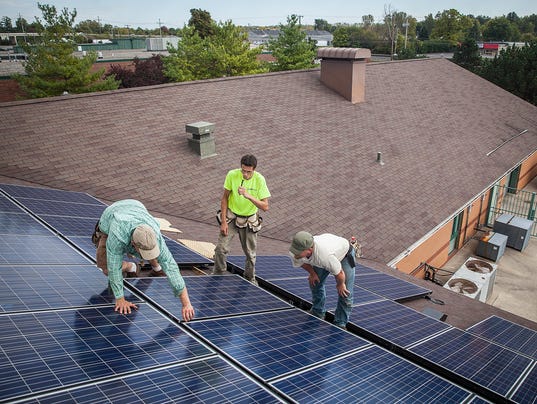Five solar energy projects under way
MUNCIE — A solar energy construction spree is in progress throughout the city to cut utility bills, educate the public and fight climate change.
Installation of solar panels is under way at the Youth Opportunity Center, to be followed by more projects at Kennedy Library, an ecoREHAB house in the Old West End, the Unitarian Universalist Church on the northwest side and Shaffer Chapel AME Church in Whitely.
"This sort of project can really bring in a lot of diverse people," said Chris Randolph, pastor at Shaffer Chapel, a predominantly African-American denomination. "Solar energy crosses all boundaries. There is no one that doesn't want to have better energy and pay less. If we can do it at the church, then we can do it at homes."
ecoREHAB, a nonprofit organization that collaborates with Ball State University and the city, is installing eight solar panels — each measuring about 3 feet by 7 feet and weighing 50 pounds — on the roof of a house that it rehabilitated at 522 S.Gharkey St.
"We are hoping that will be enough solar panels to bring the house down to net zero electricity consumption, so we are using as much as we produce or producing as much as we use," said ecoREHAB's Craig Graybeal.
The house is heated with gas but air-conditioned with electricity, which also runs the appliances, lights and plug loads.
When you factor in tax credits, electricity savings and feeding power back into the grid, the payback period (how long until you break even) for a residential solar project like ecoREHAB's is eight or nine years, Graybeal said. Because it's a nonprofit, ecoREHAB is ineligible for tax credits, but it did receive a grant to cover half of the project's $8,500 cost.
The library, the Unitarian church, ecoREHAB and the Youth Opportunity Center received a combined $88,250 in SUN (Solar Uniting Neighbors) grants available as the result of a legal settlement between the U.S. Environmental Protection Agency, Indiana Michigan Power and other parties.
The Unitarian church applied for solar funding as a faith response to climate change and the need to care for creation, said Holly Hanauer, a board member. Producing electricity with solar emits no pollution, produces no greenhouse gases, and uses no finite fossil fuel resources.
Another motive was to save money over the long haul.
"We wouldn't be able to get tax credits that homeowners can get, so the grant was an important incentive for us," Hanauer said. "We expect the payback time in our system to be between seven and nine years, and after that whatever energy we generate on the roof will be free."
She urged citizens to contact their representatives in Congress to extend the federal solar investment tax credit on residential/commercial properties. The credit is scheduled to expire on Jan. 1, 2017.
"Otherwise, we're going to lose momentum on this," Hanauer said.
She also recommends that citizens contact their representatives at the Statehouse to defend against utility industry attempts to cut the amount that power companies must pay when they buy excess energy generated by home systems, as well as attempts by industry to charge a "user fee" to solar customers to help utilities cover the costs of the power grid.
"There was a big fight six months ago to keep net metering in this state, and it's going to come up again," Hanauer said. "The utilities want to get rid of it."
Kennedy Library is using its $30,000 grant to help pay the estimated $88,000 cost of a 10-car solar carport with 80 panels on the roof.
"It will not save us a huge amount of money," library Director Ginny Nilles said. "It's more of an educational venture. We're mostly excited about the educational programming aspect. That's why we want to have this (solar energy) fair in April, to educate people."
The Unitarian church's solar panels won't be visible from the ground, but the church will monitor all 80 panels on its roof and show on a monitor in the foyer how much energy they are collecting.
Shaffer Chapel obtained its $10,000 solar grant through Hoosier Interfaith Power & Light (HIPL) with the same I&M legal settlement funds as the other grant recipients.
"Each congregation that gets a solar grant makes a commitment to reduce their energy use and also makes a commitment for the people in their congregation to lower energy use in their own lives," said HIPL's Mike Oles. "It's a holistic effort.
If all Indiana churches went solar, they could save $26 million a year that could "go to ministry and community work, not just the power companies," he said. "There are also huge savings out there for individuals who make their lives more energy efficient."
Contact Seth Slabaugh at (765) 213-5834.



